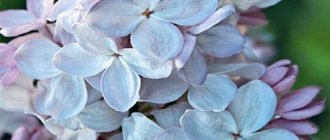1
22459
Lilac is a tree-like deciduous shrub of an ornamental type. Modern botanical reference books contain information about more than 30 species and 200 varieties of lilacs with photos and descriptions. In the last ten days of May they delight with large paniculate inflorescences of milky or lilac shades. In Russia, lilac is considered the most common of flowering shrubs due to its unpretentiousness and hardiness.
Common type of lilac with white border
Species diversity
Lilac can be considered one of the most common plants in landscape design. This is a shrub of the Olive family that often has a pleasant sweet aroma and lush and bright blooms. There are about 30 varieties. The most popular types can be considered: Amur, Chinese, Hungarian, ordinary, Persian and Himalayan lilac.
In addition to the huge variety of varieties bred by breeders, there are also wild specimens.
These plants are very beautiful and spectacular, however, you can see this for yourself by looking at a small photo selection.
From left to right. Top row: Amur lilac, Hungarian lilac. Middle row: Chinese, Regular. Bottom row: Himalayan, Persian.
Beautiful legend or true story
There is an ancient and beautiful legend about the origin of lilacs, which goes back to the gods and myths. According to her, one day the god Pan was walking through forests, meadows and fields. He saw the most beautiful nymph in the world - Syringa, who is the harbinger of the morning dawn.
Pan fell madly in love with the beauty and decided to make friends with her. But the nymph got scared and tried to run away from him. When the girl realized that she could not hide, she turned into a beautiful bush with lilac flowers.
God Pan became very sad and sat down under a bush to think. He made a pipe out of a lilac branch and began to play it. From then on, every time he started playing, he thought and yearned for his beautiful and mysterious Syringa. This is exactly how lilac appeared in the world.
This beautiful legend appeared due to the fact that translated from Greek, lilac means “tube”. And with its beauty the bush is able to conquer many hearts and souls.
The beauty was brought to Europe only in the 16th century. Since then, she has been able to conquer almost every owner of a personal plot. Today, lilac bushes can be found in almost every home - they have many varieties and colors that can decorate any area.
Beauty of Moscow
The culture blooms at the end of May with white flowers, occasionally having a light pearlescent tint. Even when buds form, the shrub has exceptional decorative properties due to its original color.
When the buds open, it attracts with an unforgettable aroma. The crown diameter is 2.5-3 meters, and the height of the bush is about 4 meters. The plant is unpretentious in care, but it is better to plant it in open ground from mid-summer to September, having previously fertilized the soil with organic matter.
Mme Lemoine
Another exotic variety of lilac with white inflorescences consisting of large, double flowers. The shrub reaches 7 meters in height and has tough, branching shoots that can intertwine with other crops, so even for planting a young seedling it is necessary to provide sufficient space in a sunny area.
The variety will not lose its decorative appearance even after flowering, since the green glossy leaves remain until the beginning of September.
Girlish blush
A delicate and graceful bush, reaching no more than two meters in height and width, yet it has lush inflorescences that abundantly cover the bush from the first years of growth. The flowers are pink with a light pearly sheen.
Early flowering occurs in early or mid-May, filling the garden with light notes of aromas and a neat appearance. The plant is unpretentious in choosing soil, but develops more actively in sunny areas with well-drained soil.
Landing Features
Dark varieties of lilac (photos with descriptions will explain the features of planting a flower) are allowed to be planted in open areas in the spring season, from late April to early May, or in the autumn, from September to October. The site should be level, open and sunny. The plant cannot withstand waterlogging, so low-lying areas with high groundwater levels are not suitable.
10 days before disembarkation, it is necessary to prepare a landing recess, which should be spacious:
- if the soil mixture is light, the depth of the hole should be 40 cm, width - 50 cm;
- when planting in a heavy substrate, the depth of the hole should be 60 cm, diameter - 70 cm.
If the soil layer is acidic, you will need to add 2 kg of calcareous tuff; if it is sandy, you must use dolomite flour, since it contains magnesium, which is lacking in this type of substrate.
Additionally, organic matter with mineral fertilizer must be added to the recess:
- a bucket of weathered peat with humus;
- 200 g granulated superphosphate;
- 120 g of potassium sulfate;
- 700 g wood ash;
- 1/2 bucket of half-rotted manure.
Step-by-step planting instructions:
- Mix the contents of the planting hole with a shovel, forming an earthen mound in the middle of the hole.
- Install the seedling's root system on the hill, leveling the roots. Place the root collar 5 cm above the surface of the substrate.
- Cover the roots with turf soil, which has been mixed with humus. Irrigate the young plant abundantly, sprinkling the circle around the trunk with a layer of peat, the thickness of which should be 3 cm.
If the roots of a seedling with an open root system have dried out, they must first be dipped into a manure-clay mash. When it dries, you can plant it.
President Grevy
A terry variety of blue lilac, characterized by a rich aroma that can fill the entire space of a personal plot. A medium-sized shrub, does not exceed 4 meters in height with a crown diameter of about 3 meters. The culture will delight you with its active growth - about 30 centimeters per year.
To do this, you need to observe important aspects when choosing the soil - it must be light, drained and fertilized before planting. Already an adult plant, it will calmly tolerate any pruning for the purpose of forming a hedge, and will also calmly react to frosty winters.
The most popular representatives
“In Memory of Ludwig Späth” - widely distributed due to its dark color and delicate aroma.
Andenken an Ludwig SpäthCommon lilac “Red Moscow”, “Beauty of Moscow”, “Primrose”, Meyer’s lilac, “Buffon”, “Charles Joly” are no less popular and attractive. They were also noted by gardeners as the most fragrant specimens.
Monique Lemoine, Flora, Nadezhda, “Memory of Vekhov”, according to reviews, were distinguished by their unique flowering, and therefore are so desirable on the plots of every gardener.
Each variety is unique in its own way, and among such a riot of colors, everyone will find something they like.
History of the name
The lilac plant became known to the Slavic people in the 14th century, and was first brought from Turkish lands.
The history of the origin of the pleasantly smelling shrub is quite interesting and shrouded in many legends. One of them says that lilac got its name from the ancient Greek goddess Syringa, who, turning into a flowering bush, escaped from the advances of the god Pan. The voluptuous man had long sought the beauty’s attention, but was constantly refused. Unable to bear another decisive “no,” Pan began to pursue Syringa, and she, in order to somehow preserve her honor, turned into a pleasantly smelling lilac bush.
The second legend says that the beautiful plant is the work of the goddess of Spring. While coloring the waking Earth, the girl was so carried away by her work that there were no colors left in her palette except white and purple. Since there were still unpainted areas on the planet, she mixed the remaining shades and, using a solar ray, brought them down to the ground. At that very moment, where the messenger of Spring touched the soil, beautiful shrubs with small unusual flowers and a delicate aroma sprouted.
From a scientific point of view, the shrub, which belongs to the olive family, currently has more than 35 species of wild representatives, which are scattered in various parts of our planet. Thus, common wild lilac is found not only in Russia and Ukraine, but also in Japan, China, the Balkans, Hungary and Asia.











